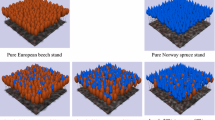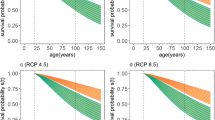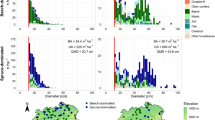Abstract
The study provides an improved bioeconomic model of mixed-species stands in order to test the economic consequences of tree species mixtures composed of spruce (Picea abies [L.] Karst.) and beech (Fagus sylvatica L.), when the impact of mixing tree species on stand resistance against hazards is considered. We used survival probabilities of spruce in mixed- and mono-species stands derived by Griess et al. (For Ecol Manag 267:284–296, 2012) to expand an existing bioeconomic model by Knoke and Seifert (Ecol Model 210:487–498, 2008). Monte-Carlo simulations showed the highest average net present value (sum of all net revenues during one rotation period discounted by 2 %) for spruce stands with a small beech admixture of 7 % of total stems. The net present value of this mixed stand type was 8 % higher than that reached with a spruce monoculture, while risk—measured as standard deviation of net present value—was 18 % lower than that of a pure spruce stand. A mixed stand with 51 % beech led to a decrease of 23 % of the average net present value when compared to a spruce monoculture. However, the stabilizing effect of this high proportion of beech trees on spruce together with general economic diversification effects (as a result from low correlation of hazard and market risks of both tree species) reduced the standard deviation of the net present value by 55 %. Generally, an intensive species mixture in groups, with interactions between species throughout the stand, led to higher net present values and lower risks when compared to mixtures of identical proportions in large homogenous blocks without species interactions. For calculating survival probability, data from Rhineland-Palatinate were used, for modeling growth, data were based on information gained in Bavaria. It can be assumed that susceptibility toward windthrow was underestimated with respect to Bavarian conditions or growth was overestimated with respect to Rhineland-Palatinate conditions. This narrows the explanatory power of the study at hand and—once again—highlights the importance of a standardization of inventory processes all over Europe. Still the strong potential of mixing species is proven by the results. The hypothesis, derived from simpler, more traditional bioeconomic models that mixed-species stands are economically inferior to mono-species stands, could therefore be rejected. Of particular relevance to practicing foresters is the result that even mild admixtures may lead to substantial positive economic consequences. With relatively small initial investments then, a considerable increase in efficiency can be expected. This finding makes the admixture of at least small proportions interesting for the privately owned forest sector.





Similar content being viewed by others
References
Albrecht A, Hanewinkel M, Bauhus J, Kohnle U (2012) How does silviculture affect storm damage in forests of south-western Germany? Results from empirical modelling based on long-term observations. Eur J For Res 131:229–247
Armstrong CW (2007) A note on the ecological-economic modelling of marine reserves in fisheries. Ecol Econ 62:242–250
Bauhus J, Puettmann K, Messier C (2006) Der Einfluss von Baumartenmischungen auf Nährstoffkreisläufe und Bestandesproduktivität—Eine Fallstudie mit Meischbeständen aus Eucalyptus globulus und Acacia mearnsii. In: Ammer C, Schölch M, Mosandl R (eds) Der Beitrag des Waldbaus zur Mischwaldforschung. Jahrestagung der Sektion Waldbau. Deutscher Verband Forstlicher Forschungsanstalten (DVFFA)
Beimgraben T (2002) Auftreten von Wachstumsspannungen im Stammholz der Buche (Fagus sylvatica L.) und Möglichkeiten zu deren Verminderung, Freiburg (Breisgau), p 235
Beinhofer B (2007) Zum Einfluss von Risiko auf den optimalen Zieldurchmesser der Fichte. Forstarchiv 78:117–124
Beinhofer B (2010) Producing softwood of different quality: does this provide risk compensation? Eur J For Res 129:921–934
Benítez PC, McCallum I, Obersteiner M, Yamagata Y (2007) Global potential for carbon sequestration: geographical distribution, country risk and policy implications. Ecol Econ 60:572–583
Bernier P, Schoene D (2009) Adapting forests and their management to climate change: an overview. Unasylva 60:5–12
Bleile K (2006) Vorkommen und Analyse von Zugholz bei Buche (Fagus sylvatica L.) als Ursache von Spannungen im Rundholz und Verwerfungen des Schnittholzes, Dissertation, Freiburg (Breisgau), p 174
Bulte EH, van Kooten GC (1999) Metapopulation dynamics and stochastic bioeconomic modeling. Ecol Econ 30:293–299
Chen HYH, Klinka K, Mathey AH, Wang X, Varga X, Chourmouzis C (2003) Are mixed-species stands more productive than single-species stands: an empirical test of three forest types in British Columbia and Alberta. Can J For Res 33:1227–1237
Clasen C, Griess VC, Knoke T (2011) Financial consequences of losing admixed tree species: a new approach to value increased financial risks by ungulate browsing. For Policy Econ 13:503–511
Cubbage F, Mac Donagh P, Sawinski Junior J, Rubilar R, Donoso P, Ferreira A, Hoe-flich V, Morales Olmos V, Ferreira G, Balmelli G, Siry J, Báez MN, Alvarez J (2007) Timber investment returns for selected plantations and native forests in South America and the Southern United States. New For 33:237–255
Dieter M (2001) Land expectation values for spruce and beech calculated with Monte Carlo modelling techniques. For Policy Econ 2:157–166
Forrester DI, Smith RGB (2012) Faster growth of Eucalyptus grandis and Eucalyptus pilularis in mixed-species stands than monocultures. For Eco Manag 286:81–86
Glomb P (2007) Statistische Modelle und Methoden in der Analyse von Lebenszeitdaten. Diplomarbeit. Carl von Ossietzky Universität, Oldenburg. Institut für Mathematik. Thesis
Griess VC, Knoke T (2011a) Growth performance, windthrow, and insects: meta-analyses of parameters influencing performance of mixed-species stands in boreal and northern temperate biomes. Can J For Res 41:1141–1159
Griess VC, Knoke T (2011b) Can native tree species plantations in Panama compete with Teak plantations? An economic estimation. New For 41:13–39
Griess VC, Acevedo R, Härtl F, Staupendahl K, Knoke T (2012) Does mixing tree species enhance stand resistance against natural hazards? A case study for spruce. For Ecol Manage 267:284–296
Hein S, Collet C, Ammer C, Le Goff N, Skovsgaard JP, Savill P (2009) A review of growth and stand dynamics of Acer pseudoplatanus L. in Europe: implications for silviculture. Forestry 82:361–385
Holecy J, Hanewinkel M (2006) A forest management risk insurance model and its application to coniferous stands in southwest Germany. For Policy Econ 8(2):161–174
Kelty MJ (2006) The role of species mixtures in plantation forestry. For Ecol Manage 233:195–204
Kennel R (1965) Untersuchungen über die Leistung von Fichte und Buche im Rein- und Mischbestand. Teil I. Allgemeine Forst- und Jagdzeitung 136:149–161
Knoke T (2003) Eine Bewertung von Nutzungsstrategien für Buchenbestände (Fagus sylvatica L.) vor dem Hintergrund des Risikos der Farbkernbildung. Technische Universität München, p 211
Knoke T, Seifert T (2008) Integrating selected ecological effects of mixed European beech -Norway spruce stands in bioeconomic modelling. Ecol Model 210:487–498
Knoke T, Wurm J (2006) Mixed forests and a flexible harvest policy: a problem for conventional risk analysis? Eur J For Res 125:303–315
Knoke T, Stimm B, Ammer C, Moog M (2005) Mixed forests reconsidered: a forest economics contribution on an ecological concept. For Ecol Manage 213:102–116
Knoke T, Ammer C, Stimm B, Mosandl R (2008) Admixing broadleaved to coniferous tree species: a review on yield, ecological stability and economics. Eur J For Res 127:89–101
Knoke T, Schneider T, Hahn A, Griess VC, Roessiger J (2012) Forstbetriebsplanung als Entscheidungshilfe. Ulmer, Stuttgart
Kouba J (2002) Das Leben des Waldes und seine Lebensunsicherheit. Forstwissenschaftliches Centralblatt 121(4):211–228
Lemprière TC, Bernier P, Carroll A, Flannigan M, Gilsenan R, McKenney D (2008) The importance of forest sector adaptation to climate change. Rep. NOR-X-416. Edmonton
Man RZ, Greenway KJ (2013) Effects of soil moisture and species composition on growth and productivity of trembling aspen and white spruce in planted mixtures: 5-year results. New For 44:23–38
Morin X, Fahse L, Scherer-Lorenzen M, Bugmann H (2011) Tree species richness promotes productivity in temperate forests through strong complementarity between species. Ecol Lett 14:1211–1219
Nürnberger K (2011) Zur Wirkung von Einkommensteuer auf die Wahl waldbaulicher Alternativen: Eine Simulationsstudie aus der Sicht eines risikomeidenden Entscheiders. Master thesis, Technische Universität München, Institute of Forest Management
Petit B, Montagnini F (2006) Growth in pure and mixed plantations of tree species used in reforesting rural areas of the humid region of Costa Rica, Central America. For Ecol Manage 233:338–343
Piotto D, Montagnini F, Ugalde L, Kanninen M (2003) Growth and effects of thinning of mixed and pure plantations with native trees in humid tropical Costa Rica. For Ecol Manage 177:427–439
Poudel BC, Sathre R, Gustavsson L, Bergh J, Lundström A, Hyvönen R (2011) Effects of climate change on biomass production and substitution in north-central Sweden. Biomass Bioenergy 35(10):4340–4355
Pretzsch H (2003) Diversität und Produktivität von Wäldern. Allgemeine Forst- und Jagdzeitung 147:88–98
Pretzsch H (2005) Stand density and growth of Norway spruce (Picea abies (L.) Karst.) and European beech (Fagus sylvatica L.): evidence from long-term experimental plots. Eur J For Res 124:193–205
Pretzsch H (2009) Forest dynamics, growth and yield. A review, analysis of the present state, and Perspective. Springer, Berlin
Pretzsch H, Kahn M (1998) Konzeption und Konstruktion des Wuchsmodells SILVA 2.2. Abschlussbericht zum Projekt W 28, Teil 2 (Methodische Grundlagen), unpublished, p 257
Pretzsch H, Schütze G (2009) Transgressive over yielding in mixed compared with pure stands of Norway spruce and European beech in Central Europe: evidence on stand level and explanation on individual tree level. Eur J For Res 128:183–204
Pretzsch H, Biber P, Dursky J (2002) The single tree-based stand simulator SILVA: construction, application and evaluation. For Ecol Manage 162:3–21
Pretzsch H, Block J, Dieler J, Dong PH, Kohnle U, Nagel J, Spellmann H, Zingg A (2010) Comparison between the productivity of pure and mixed stands of Norway spruce and European beech along an ecological gradient. Ann For Sci 67(2010):712–723
Roessiger J, Griess VC, Härtl F, Clasen C, Knoke T (accepted) How economic performance of a stand increases due to decreased failure risk associated with the admixing of species. Ecol Mod. doi:10.1016/j.ecolmodel.2013.01.019
Röhrig E, Bartsch N, Lüpke BV (2006) Waldbau auf ökologischer Grundlage. Ulmer, Stuttgart
Schütz JP, Götz M, Schmid W, Mandallaz D (2006) Vulnerability of spruce (Picea abies) and beech (Fagus sylvatica) forest stands to storms and consequences for silviculture. Eur J For Res 125:261–302
Seifert T (2008) Einfluß der waldbaulichen Behandlung auf die Holzqualität von Fichte und Buche in Rein- und Mischbeständen. Abschlußbericht des Projekte X33—Teil II Bayerische Landesanstalt für Wald- und Forstwirtschaft, Freising
Spellmann H (2005) Produziert der Waldbau am Markt vorbei? AFZ - Der Wald 60(9):454–459
Spellmann H (2010) Nachhaltige Waldbewirtschaftung auf ökologischen Grundlagen Waldeigentum. Bibliothek des Eigentums 8(3):99–116
Spiecker H (2003) Silvicultural management in maintaining biodiversity and resistance of forests in Europe-temperate zone. J Environ Manage 67:55–65
Stange EE, Ayres MP (2010) Climate change impacts: insects encyclopedia of life sciences. Wiley, Chichester
Staupendahl K, Zucchini W (2011) Schätzung von Überlebensfunktionen der Hauptbaumarten auf der Basis von Zeitreihendaten der Rheinland-Pfälzischen Waldzustandserhebung. Allg Forst- u Jagdztg 182:129–145
Thommen J-P, Achleitner A-K (2009) Allgemeine Betriebswirtschaftslehre—Umfassende Einführung aus managementorientierter Sicht, 6th edn. Gabler, Wiesbaden
Valinger E, Fridman J (2011) Factors affecting the probability of windthrow at stand level as a result of Gudrun winter storm in southern Sweden. For Ecol Manage 262:398–403
Vallet P, Pérot T (2011) Silver fir stand productivity is enhanced when mixed with Norway spruce: evidence based on large-scale inventory data and a generic modelling approach. J Veg Sci 22:932–942
Vose D (2008) Risk analysis, a quantitative guide, 3rd edn. Wiley, Chichester
Weibull W (1951) A statistical distribution function of wide. J Appl Mech 18:293–297
Williamson T, Price D, Beverly J, Bothwell P, Frenkel B, Park J, Patriquin (2008) Assessing potential biophysical and socioeconomic impacts of climate change on forest-based communities: a methodological case study. Rep. NOR-X-415E., Edmonton
Acknowledgments
The study presented here is part of the projects “Bioeconomic modelling and optimization of forest stands: Towards silvicultural economics” KN 586/7-1 and “Uncertainty and the bioeconomics of near-natural silviculture” KN 586/7-2 both funded by the German Research Foundation (DFG). The authors wish to thank Laura Carlson for the language editing of the manuscript and the anonymous reviewers for valuable comments.
Author information
Authors and Affiliations
Corresponding author
Additional information
Communicated by A. Weiskittel.
Rights and permissions
About this article
Cite this article
Griess, V.C., Knoke, T. Bioeconomic modeling of mixed Norway spruce—European beech stands: economic consequences of considering ecological effects. Eur J Forest Res 132, 511–522 (2013). https://doi.org/10.1007/s10342-013-0692-3
Received:
Revised:
Accepted:
Published:
Issue Date:
DOI: https://doi.org/10.1007/s10342-013-0692-3




